
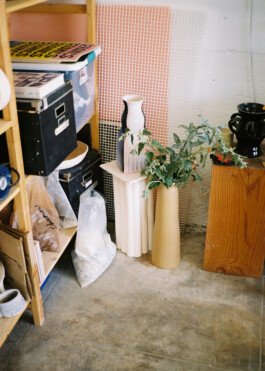
Studio Hecha
Welcome to the ever-evolving ceramic practice of Haley Ann Bradley, who's blending analog and digital processes—shaped by dual landscapes, creative collaboration, and a deep love of material exploration.
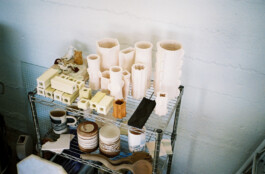
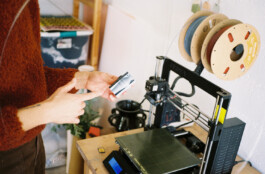
I love a converted garage! This is such a great studio.
Thank you! It has its pros and cons, but ultimately, it makes the most sense for me right now. Sometimes cutting out the nonsense and working with what's left brings out new resourcefulness.
Your practice is deeply influenced by the contrast between the lushness of the Pacific Northwest and the weathered textures of Los Angeles. How do these dual landscapes manifest in your work? The textures and colors you create are stunning.
I appreciate that! Color has always been a major aspect of my work, both in design and in clay. This relationship is something I think about a lot—not just visually, but in terms of rhythm and energy. The Pacific Northwest gives me this deep sense of slowness and softness, while L.A. brings this sun-baked grit and intensity. My work often lands somewhere in between—lush but structured, weathered but deliberate. There’s also a quiet dialogue between the architecture of both places that stays with me—it definitely informs how I think about structure, form, and the way surfaces hold color or texture.
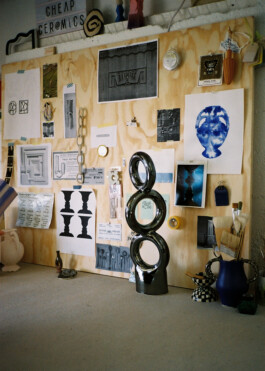
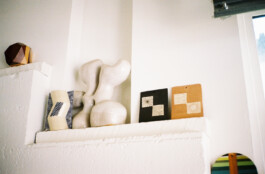
“Sometimes cutting out the nonsense and working with what's left brings out new resourcefulness.”
You’ve been working with clay since 2011—what first drew you to ceramics, and how has your relationship with the medium evolved over time?
I came to ceramics through curiosity and a love of tactile materials. Back in 2011, I wasn’t thinking about permanence or tradition—I was more interested in how clay offered something entirely different from the digital work I was doing at the time. Clay had a way of slowing me down and required a lot of presence and patience. The process forces you to be here now.
Over time, it’s become a language I speak fluently, but I still let it surprise me. Especially now, with 3D printing, I’m constantly negotiating that space between control and surrender. In a funny full-circle way, I’ve found myself back on the computer with this medium—but I love the challenge of learning a new 3D program and the expanded possibilities it brings to the work.
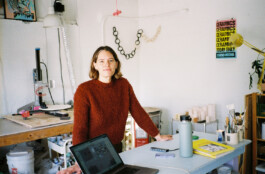
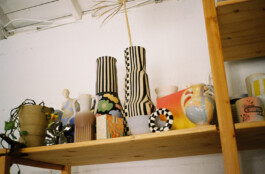
What has surprised you most about working with 3D ceramic printing? Has it changed the way you think about traditional hand-building techniques?
100%—it’s changed the way I think about hand-building. Working with the printer cracked open a completely new way of thinking for me—especially when it comes to form and design.
For years, I worked primarily on the wheel, which naturally lends itself to cylindrical shapes because of its rotational nature. Unless you significantly alter the piece afterward, you’re always starting from that same circular base. With printing, those limitations fall away. I can now design in real time, adjusting forms back and forth with the printer, and exploring shapes that aren’t bound to symmetry or rotational constraints.
I’ve trained my mind to sketch in 3D—often beginning with loose ideas that I translate into Rhino. It doesn’t always work on the first print, but each attempt gives me new information. I go back into the program, tweak the model, and keep iterating until the form lands. So the sketching phase is still very tactile—it’s still clay, still responsive, still alive—but the process forces a kind of forward-planning that’s very different from the immediacy of hand-building. What’s wild is how often I find myself looping back to traditional techniques to solve problems that arise with digital tools. I love that ongoing conversation between ancient and futuristic—it keeps me engaged and curious.
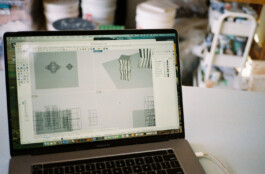
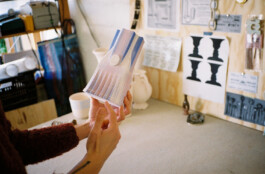
“I love that ongoing conversation between ancient and futuristic—it keeps me engaged and curious.”
You’ve exhibited across the country in spaces like Hashimoto, Schacht, and Two Two—how have these experiences shaped your journey?
Each show has been a different kind of mirror. Some helped me understand how my work sits in space—how it interacts with architecture and proximity—while others pushed me to think more about pacing, narrative, or scale. Exhibiting has also shifted how I approach bodies of work—what it means to build a cohesive experience versus making standalone pieces. Being in dialogue with curators and other artists has also been huge, and I’m excited to operate in that space more intentionally moving forward.
Your new show, The Breaking of New Blooms, is currently at And Friends Gallery in Santa Cruz. Can you share more about this body of work?
The Breaking of New Blooms feels like a turning point for me—both conceptually and technically. The title comes from a Truman Capote quote about hearing the blooms break open after a spring rain. It captures growth in such a poetic way. The quote really stuck with me, and it felt significant—like a moment where so many threads in my practice were starting to come together. It felt like a kind of kismet, a meeting point between the evolution of my work and my own growth as an artist—taking risks, trusting my gut, trusting the work.
I was also lucky enough to show alongside my husband and creative partner. We’ve never had the opportunity to exhibit together before, so it felt really special to share that space. I admire his work deeply, and getting to show alongside him added another layer of meaning to the experience.
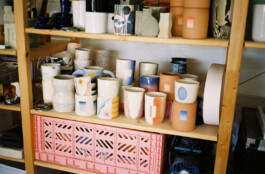
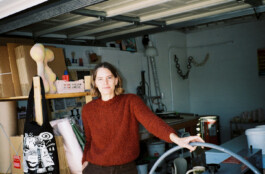
You and your husband, Thomas Bradley, started Famous Charm, a creative agency. How does your work in ceramics intersect with the projects you take on through the agency?
For the most part, Famous Charm lives in a totally different creative lane than my ceramics practice, but every now and then, there’s a bit of crossover. I tend to keep the two separate so each can have its own rhythm and focus. That said, it’s always exciting when a project lets me bring some of that tactile, material-driven thinking into a different context. And if anything, the life lessons ceramics has taught me are lessons I take with me in a lot of work/life situations.
Are there any materials or techniques you’re eager to experiment with next?
I’m currently experimenting with a few new directions—playing with the idea of ceramic light fixtures and some elevated decor pieces that feel like a natural extension of my sculptural work. I’m always testing new clay bodies and glaze combinations, and continuing to tint clays as a way of building pattern and color directly into the material. Surface and form are still central, but I’m interested in how they can live in other functional or environmental contexts.
If you could collaborate with any artist or designer—past or present—who would it be and why?
I’d love to be in conversation with someone like Marianne Brandt, Wang & Söderström, or the house of Schiaparelli. Each explores material and form in ways that differ from my own practice, yet all push their mediums beyond convention and reflect a kind of inventiveness I really admire.
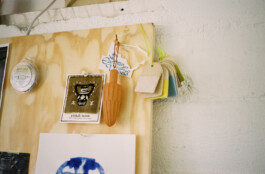
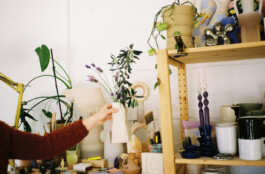
What’s your current take on social media’s role in the art world? Do you feel pressure to share everything, or do you take a more selective approach?
Oof, I’ve got big feelings about social media. Part of me genuinely loves sharing what I’m working on—it can be exciting to bring people into the process—but I’ve also learned the value of keeping some things just for myself. Those quiet, private moments with the work feel grounding and healthy. I’ve also found that social can be a distraction in the studio, breaking my concentration, so I try to limit my usage when I’m in work mode.
Instagram, specifically, has become more like a living portfolio—something potential clients, collaborators, or supporters can visit to get a clear sense of my work. While it’s mostly professional, I do share bits of personal life now and then. The people who are interested will stick around, and others may fade out. I think that ebb and flow is part of the natural rhythm as my practice continues to evolve and shift.
It’s taken some real rewiring to stop caring about the numbers. Likes feel too much like currency these days, and I try not to let that dictate what I share. If I’m excited about something and it reflects the kind of work I want to be doing, that’s enough. Social media itself is always evolving—and the ways people engage with it keep shifting, too. I try to stay flexible and focused on what feels right for me. Despite all the noise, I still value the genuine connections it can create—I’ve met incredible people through social who’ve become part of my creative world in real life, and that’s the part I want to nurture.
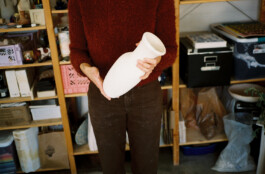
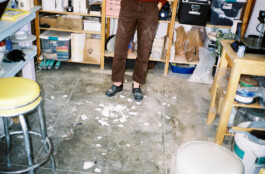
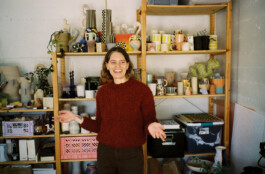
“My work often lands somewhere in between—lush but structured, weathered but deliberate.”
Have you got the travel bug?
Always!! I’m actively trying to mix work and travel, and have been applying to residencies. Hopefully something lands soon—I’d love the chance to be fully immersed in a new environment and create work that responds to that firsthand experience.

Studio Hecha

Welcome to the ever-evolving ceramic practice of Haley Ann Bradley, who's blending analog and digital processes—shaped by dual landscapes, creative collaboration, and a deep love of material exploration.


I love a converted garage! This is such a great studio.
Thank you! It has its pros and cons, but ultimately, it makes the most sense for me right now. Sometimes cutting out the nonsense and working with what's left brings out new resourcefulness.
Your practice is deeply influenced by the contrast between the lushness of the Pacific Northwest and the weathered textures of Los Angeles. How do these dual landscapes manifest in your work? The textures and colors you create are stunning.
I appreciate that! Color has always been a major aspect of my work, both in design and in clay. This relationship is something I think about a lot—not just visually, but in terms of rhythm and energy. The Pacific Northwest gives me this deep sense of slowness and softness, while L.A. brings this sun-baked grit and intensity. My work often lands somewhere in between—lush but structured, weathered but deliberate. There’s also a quiet dialogue between the architecture of both places that stays with me—it definitely informs how I think about structure, form, and the way surfaces hold color or texture.


“Sometimes cutting out the nonsense and working with what's left brings out new resourcefulness.”
You’ve been working with clay since 2011—what first drew you to ceramics, and how has your relationship with the medium evolved over time?
I came to ceramics through curiosity and a love of tactile materials. Back in 2011, I wasn’t thinking about permanence or tradition—I was more interested in how clay offered something entirely different from the digital work I was doing at the time. Clay had a way of slowing me down and required a lot of presence and patience. The process forces you to be here now.
Over time, it’s become a language I speak fluently, but I still let it surprise me. Especially now, with 3D printing, I’m constantly negotiating that space between control and surrender. In a funny full-circle way, I’ve found myself back on the computer with this medium—but I love the challenge of learning a new 3D program and the expanded possibilities it brings to the work.


What has surprised you most about working with 3D ceramic printing? Has it changed the way you think about traditional hand-building techniques?
100%—it’s changed the way I think about hand-building. Working with the printer cracked open a completely new way of thinking for me—especially when it comes to form and design.
For years, I worked primarily on the wheel, which naturally lends itself to cylindrical shapes because of its rotational nature. Unless you significantly alter the piece afterward, you’re always starting from that same circular base. With printing, those limitations fall away. I can now design in real time, adjusting forms back and forth with the printer, and exploring shapes that aren’t bound to symmetry or rotational constraints.
I’ve trained my mind to sketch in 3D—often beginning with loose ideas that I translate into Rhino. It doesn’t always work on the first print, but each attempt gives me new information. I go back into the program, tweak the model, and keep iterating until the form lands. So the sketching phase is still very tactile—it’s still clay, still responsive, still alive—but the process forces a kind of forward-planning that’s very different from the immediacy of hand-building. What’s wild is how often I find myself looping back to traditional techniques to solve problems that arise with digital tools. I love that ongoing conversation between ancient and futuristic—it keeps me engaged and curious.


You’ve exhibited across the country in spaces like Hashimoto, Schacht, and Two Two—how have these experiences shaped your journey?
Each show has been a different kind of mirror. Some helped me understand how my work sits in space—how it interacts with architecture and proximity—while others pushed me to think more about pacing, narrative, or scale. Exhibiting has also shifted how I approach bodies of work—what it means to build a cohesive experience versus making standalone pieces. Being in dialogue with curators and other artists has also been huge, and I’m excited to operate in that space more intentionally moving forward.
Your new show, The Breaking of New Blooms, is currently at And Friends Gallery in Santa Cruz. Can you share more about this body of work?
The Breaking of New Blooms feels like a turning point for me—both conceptually and technically. The title comes from a Truman Capote quote about hearing the blooms break open after a spring rain. It captures growth in such a poetic way. The quote really stuck with me, and it felt significant—like a moment where so many threads in my practice were starting to come together. It felt like a kind of kismet, a meeting point between the evolution of my work and my own growth as an artist—taking risks, trusting my gut, trusting the work.
I was also lucky enough to show alongside my husband and creative partner. We’ve never had the opportunity to exhibit together before, so it felt really special to share that space. I admire his work deeply, and getting to show alongside him added another layer of meaning to the experience.


You and your husband, Thomas Bradley, started Famous Charm, a creative agency. How does your work in ceramics intersect with the projects you take on through the agency?
For the most part, Famous Charm lives in a totally different creative lane than my ceramics practice, but every now and then, there’s a bit of crossover. I tend to keep the two separate so each can have its own rhythm and focus. That said, it’s always exciting when a project lets me bring some of that tactile, material-driven thinking into a different context. And if anything, the life lessons ceramics has taught me are lessons I take with me in a lot of work/life situations.
Are there any materials or techniques you’re eager to experiment with next?
I’m currently experimenting with a few new directions—playing with the idea of ceramic light fixtures and some elevated decor pieces that feel like a natural extension of my sculptural work. I’m always testing new clay bodies and glaze combinations, and continuing to tint clays as a way of building pattern and color directly into the material. Surface and form are still central, but I’m interested in how they can live in other functional or environmental contexts.
If you could collaborate with any artist or designer—past or present—who would it be and why?
I’d love to be in conversation with someone like Marianne Brandt, Wang & Söderström, or the house of Schiaparelli. Each explores material and form in ways that differ from my own practice, yet all push their mediums beyond convention and reflect a kind of inventiveness I really admire.


What’s your current take on social media’s role in the art world? Do you feel pressure to share everything, or do you take a more selective approach?
Oof, I’ve got big feelings about social media. Part of me genuinely loves sharing what I’m working on—it can be exciting to bring people into the process—but I’ve also learned the value of keeping some things just for myself. Those quiet, private moments with the work feel grounding and healthy. I’ve also found that social can be a distraction in the studio, breaking my concentration, so I try to limit my usage when I’m in work mode.
Instagram, specifically, has become more like a living portfolio—something potential clients, collaborators, or supporters can visit to get a clear sense of my work. While it’s mostly professional, I do share bits of personal life now and then. The people who are interested will stick around, and others may fade out. I think that ebb and flow is part of the natural rhythm as my practice continues to evolve and shift.
It’s taken some real rewiring to stop caring about the numbers. Likes feel too much like currency these days, and I try not to let that dictate what I share. If I’m excited about something and it reflects the kind of work I want to be doing, that’s enough. Social media itself is always evolving—and the ways people engage with it keep shifting, too. I try to stay flexible and focused on what feels right for me. Despite all the noise, I still value the genuine connections it can create—I’ve met incredible people through social who’ve become part of my creative world in real life, and that’s the part I want to nurture.



“I love that ongoing conversation between ancient and futuristic—it keeps me engaged and curious.”